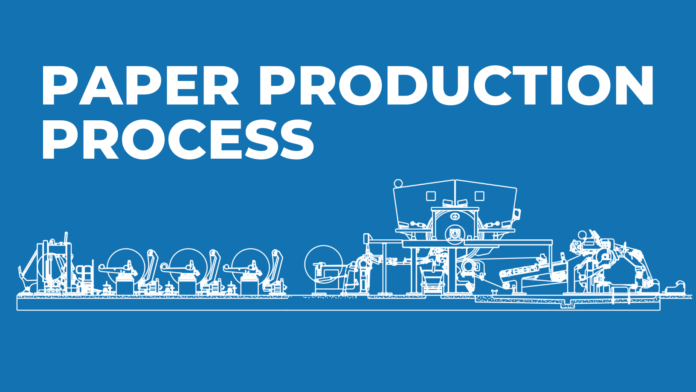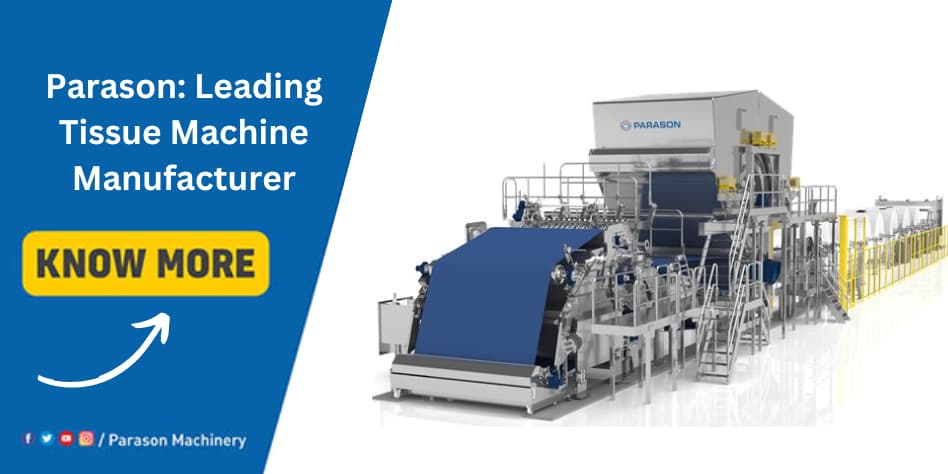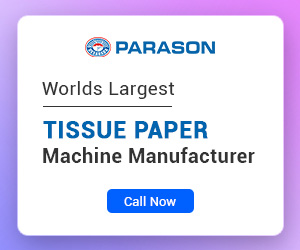The paper industry plays a crucial role in the global economy. It supports various sectors like packaging, printing, hygiene, and education. But have you ever wondered how is this paper made? What is the paper production process?
In this blog, we will see the detailed paper production process and look into some important machinery that are crucial for the paper manufacturing process.
Despite the rise of digital media, the demand for paper remains strong due to its versatility and importance in everyday life. According to some research and reports, the global production of paper and cardboard reached around 400 million tons in 2022. This figure is expected to grow gradually in upcoming years as the demand for packaging, office paper, and tissue paper is still high.
Let’s dive into the detailed information about the paper production process and learn the step-by-step process.
Types of Paper
Paper can be classified in various categories based on its use, quality, and type of production.
So far, the common types of paper include, writing and printing paper, packaging paper, tissue paper, and specialty paper.
The Paper Production Process: Step by Step
The paper production process involves multiple stages. These steps are mostly common in both virgin and recycled paper production processes.
The virgin type involves the wood as raw material and the recycled paper production process involves used papers, packaging paper, and other recyclable paper products.
Let’s have a look at the paper production process step-by-step.
1. Raw Material Preparation
The primary raw material for paper production is wood, although other sources such as recycled paper, cotton, and bamboo can also be used. The wood is debarked and chipped into small pieces, ready for further processing.
2. Pulping
In this process, the chipped wood or the paper bale collected for recycling is processed through a pulper to break down into a slurry. The pulp consists of cellulose fibers, which are the building blocks of paper. The main two types of pulping involve Mechanical pulping which is done for wood chips, and Chemical pulping which is mainly used for kraft paper.
3. Cleaning and Screening
In this process, the pulp is cleaned and the cleaning process is done by the various types of cleaners. The cleaner uses the centrifugal force to remove the heavy impurities from the pulp. After the cleaning process, the pulp is processed through the screening process. In this process, the screening equipment is used to pass the pulp through the screen baskets and improve the pulp quality.
4. Bleaching
For white or lighter paper, the pulp needs to undergo a bleaching process to remove the natural color of the wood. Chlorine-free chemicals, such as oxygen, hydrogen peroxide, and ozone, are often used to whiten the pulp while minimizing environmental impact.
5. Pulp Refining
In this stage, the pulp is passed through the refiners and it is refined to improve the bonding of the fibers. The refining process mechanically treats the fibers, making them more flexible and improving their ability to interweave. This step is essential for enhancing the paper’s strength and quality.
6. Forming
The refined pulp is mixed with water, creating a slurry of water and fiber. This slurry is then spread across the forming section of the paper machine. This is done with the help of the headbox. Here, the water drains through a mesh, and the fibers begin to form a continuous sheet of paper.
6. Pressing
Once the pulp slurry is spread across the forming section, the dewatering starts. But even after the forming stage, the paper still contains too much water hence it is then further passed through the pressing section. The paper passes through a series of rollers that squeeze out excess water, reducing the moisture content.
7. Drying
After the pressing section, the paper sheet is passed to the drying zone. Here the paper sheet is passed on the heated cylinders which with the help of the steam inside dries the paper sheet and reduces the remaining water content. This step ensures that the paper becomes sufficiently dry and gains the necessary strength and stiffness.
8. Calendering
Calendering is the process of passing the paper through additional rollers to smooth its surface and achieve the desired thickness and texture. This step is crucial for creating a uniform and finished product suitable for specific applications, such as glossy magazine paper or rough kraft paper.
9. Cutting and Finishing
Once the paper is ready, it is rolled with the help of the pope reel. It is a huge roll that may need to be converted in smaller pieces as per need. So the paper roll is then transferred to the factory where it will be transferred into the final product after cutting and finishing.
Paper Production Machines
The paper production process completely relies on the best quality paper manufacturing machines. There are several paper manufacturing machines that you need at various stages of the paper production process. Here is the list of the different machines involved in the paper manufacturing.
- Debarker
- Chipper
- Digester
- Pulper
- Cleaner
- Screening
- Refiner
- Deinking system
- Dispersion system
- Headbox
- Yankee
- Press role
- Dryer
There are a few more machines which may be needed as per the requirement and type of the paper. If you want the best quality paper manufacturing machines then you can look for the best paper mill machine manufacturers.
You can also contact us for guidance to get your paper mill-related inquiries.
Conclusion
The paper production process is a complex process involving the transformation of raw materials into one of the most versatile products used across industries. From pulping to forming and finishing, every step of the paper-making process requires precision and efficiency
With the demand for paper products growing in emerging markets and environmental concerns pushing innovations, the paper industry remains a vital and evolving sector globally. Understanding the paper production process helps us appreciate the intricacies behind the sheets we use every day, whether for printing, packaging, or hygiene.


